Ijraset Journal For Research in Applied Science and Engineering Technology
- Home / Ijraset
- On This Page
- Abstract
- Introduction
- Conclusion
- References
- Copyright
Analysis of Mechanical Properties of Banana-Jute Hybrid Fiber-reinforced Epoxy composite by varying Stacking sequence
Authors: D. Veda Swaroop, D. Mahesh Raju, Ch. Yaswanth, Dr. Jenarthanan MP
DOI Link: https://doi.org/10.22214/ijraset.2022.40581
Certificate: View Certificate
Abstract
Nowadays, the study on natural fibers has gradually increased because of the environmental concerns due to usage of synthetic fibers. The natural fibres properties such as biodegradability, availability, strength made them a potential replacement of synthetic fibers. Hybrid Fibre reinforced composites are the composites that comprises two or more different fibres. The banana and jute fibres are selected because of their strength, moisture absorption capacity , availability. The epoxy resin is selected as a matrix to bind the fibres and to transfer a uniform load. Banana-Jute Hybrid fibre reinforced epoxy composite with different stacking sequences (BJB, BBJ, JBJ,JJB where B=Banana Fibre, J=Jute Fibre) will be fabricated by Hand-layup process for analyzing Shore hardness of composite samples and the same composite samples will be modelled in ANSYS to analyse the Flexural properties, tensile properties and Impact strength of composite samples.
Introduction
I. INTRODUCTION
A. Introduction
Composites are the materials that comprises reinforcement and matrix. The reinforcement in composite generally consists of fiber and flakes which plays a major role in providing strength and rigidity to support structural load. The matrix (organic or inorganic) helps to maintain the position, orientation of the reinforcement and transfers the external load to the reinforcement. Composite materials acquired by combining natural fibers with matrix components are called Natural Fiber Reinforced Composite. Natural fiber composites are attractive to industry because of their low density, low cost, biodegradability, and eco-friendly properties. Mostly used natural fibers are jute, banana, aloe vera, sisal, pineapple leaf and bamboo fibers. Some of the polymers that are used as matrices are epoxy, polypropylene, polyethylene, polyester.
B. Literature Review
- Aswin Sailesh, et al [2015] discussed about The banana-bamboo-glass fiber reinforced composites were fabricated by using Hand – Layup technique.The fabricated composites were tested for its flexural strength and the best flexural strength and the combination which would yield the best flexural strength was identified using Taguchi Method.It is to be noted that fiber orientation and the mixing ratio play a significant role in predicting the flexural strength of the composite material.
- Keerthi Gowda BS, et al [2018] discussed about There is an increasing trend in Tensile strength of Banana Fiber Reinforced Polyester Composites and Jute Fiber Reinforced Polyester Composites with the increase in fiber volume fraction and the optimum tensile strength is achieved at a fiber volume fraction of 25%.There is an increase in Flexural Strength of Banana Fiber Reinforced Polyester Composites and Jute Fiber Reinforced Polyester Composites with an increase in fiber volume fraction up to 20% .
- M. Harikrishna , et al [2017] discussed about The maximum flexural strength of 0.415 kN hold by the Jute-Banana-Glass fiber reinforced composites followed by Glass-Jute-Banana reinforced composites laminates which is having the value of 0.345 kN.It is suggested that these Jute-Banana-Glass fibers reinforced hybrid epoxy composites can be used as an alternate material for synthetic fiber-reinforced composite materials.
- V Manoj Kumar, et al [2020] discussed about The fabrication of banana fibre based composites with different compositions of fibre is prepared by hand layup process.It has been observed that the better mechanical properties found for C-4 composite with the composition of 50% E-glass, 10% of banana fibre and the 40% of epoxy.In water absorption test C-1(20% E-glass, 40% of banana fibre and the 40% of epoxy resin) can cause larger absorption of water. Thus the water absorption depends on the quantity of banana fiber.
- Megha.B.E, et al [2019] discussed that Jute Fiber reinforced Polyester Composites exhibit higher values of tensile and flexural strength compared to Banana Fiber reinforced Polyester Composites. However, both Banana and Jute Fiber reinforced Polyester Composites revealed optimum tensile and flexural strength at a fiber volume fraction of 25 % and 20 % respectively.
- Satish Pujari, et al carried out an experimental study to inspect about the mechanical properties of Banana-Jute hybrid fiber reinforced composites like Jute and Banana as reinforcing materials in epoxy resin based polymer matrix.Tensile and impact properties of both Jute fiber composites and Banana fiber composites were investigated as a function of fiber orientation. Results showed that the composite properties are strongly influenced by test direction and fabric characteristics. Comparatively, Composites with the Jute fabric 0° orientation obtained best overall mechanical properties.
C. Materials Required
- Banana Fibre: It is a natural fibre, renewable, biodegradable, nonabrasive, and is inexpensive. The chemical composition of banana fiber is cellulose, hemicellulose, and lignin. Banana fibres (Fig 3.1.1) are waste products of banana cultivation. Therefore without any additional cost these fibres can be made for industrial purposes. The mechanical properties of different natural fibers such as sisal, vakka, banana, bamboo were compared and it was found that the banana fibers have much higher tensile and flexural properties than other fibers. Banana is one of the ecological materials for which it has many distinct characteristics such as: Fire retardant and water resistant, Unbreakable, maintenance free, durable, Less abrasive, Less costly, Biodegradable, Renewable, Eco-friendly.
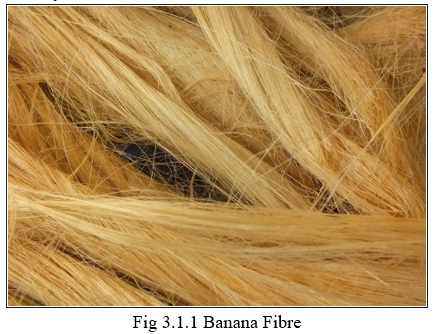
2. Jute Fibre: It is one of the cheapest natural fibres. The chemical composition of Jute fiber (3.1.2) is cellulose, lignin and pectin. It is a long, soft, shiny fiber that can be spun into coarse, strong threads.100% biodegradable recyclable and thus environment friendly .Jute is a natural fibre with golden & silky shine being the second most important and widely cultivated vegetable fibre after cotton .The high tensile strength with lower extensibility makes jute a best choice for industrial yarn and fabric for packaging.
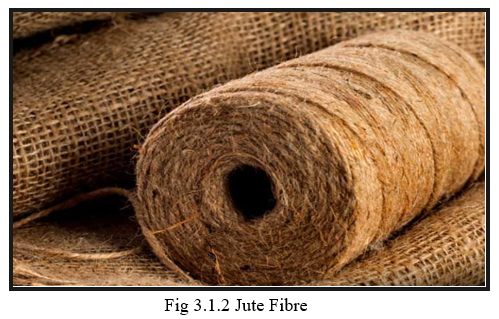
3. Epoxy Resin: Epoxy resins (FIg 3.1.3) have relatively long shelf lives. When the resin is mixed with an epoxy hardener they can cure properly. Most common epoxy resins are produced from a reaction between epichlorohydrin (ECH) and bisphenol-A (BPA), though the later may be replaced by other raw materials (such as aliphatic glycols, phenol and o-cresol novolacs) to produce specialty resins. The hardener of certain composition is added to the resin depending on the ration given for the mixture .
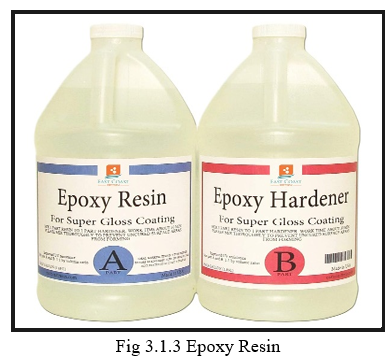
4. Roller: Rollers (Fig 3.1.4) and Squeegees are the devices that distribute resin evenly throughout the surface and it further improves your fiber-to-resin ratio and also the strength properties of the sample.They help the resin to hold reinforcement at a correct position and in eliminating the air trapped between layers of reinforcement. It also removes excess resin out of the lamination by pushing it out there by preventing brittleness.
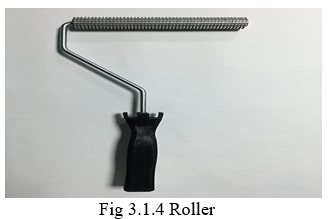
5. Mould Wax: Mold Release Wax (Fig 3.1.5) is a special type of imported waxes ,which is formulated to provide the maximum number of releases per application. This is a non-silicone white wax specially made to produce a tough, durable, high-gloss surface.
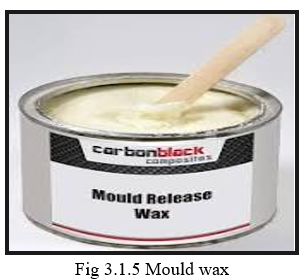
6. PVA Release Agent: It allows easy release of parts from a mold surface and is readily dissolved from molded parts and spray equipment with water. PVA(Fig 3.1.6) is the first-choice release agent when there is increased risk of a mould sticking to a pattern or even a part sticking to a mould.

II. FABRICATION OF COMPOSITE SAMPLES
The fabrication of composite samples are done by using Banana Fibre and Jute Fibre (Fig 3.2.1) as reinforcement and Epoxy resin as matrix by Hand-Layup method. Banana is a ligno-cellulosic bast fibre extracted from the pseudostem of banana plant. Jute fibre is extracted from plants in the genus Corchorus. Banana Fibre and Jute Fibre are collected in form of bidirectional mats from chennai. The resin is prepared by mixing epoxy and hardener in the ratio of 1:0.6.
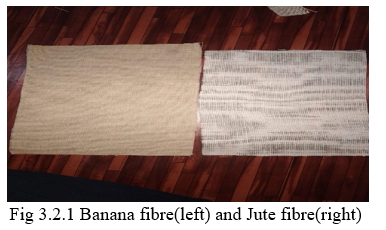
Composite samples are fabricated by the Hand-Layup process. Four samples with stacking sequence of BJB,BBJ,JBJ,JJB (where B-Banana fibre,J-Jute fibre) are fabricated. A wooden mould of size 350mmx350mm is taken.
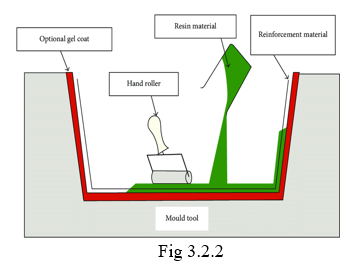
The bottom surface of the mould covered with polythene sheet was coated with Mold release agent(Wax/PVA) to avoid the stickiness of composite to the surface and left aside for 15-20 min for drying. Preforms were cut to a size of 270 mm x 200 mm and banana fiber mats and jute fiber mats were placed alternately on the bottom base plate.
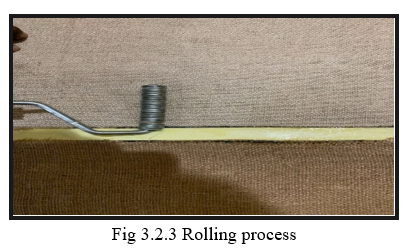
A mixture of resin and hardener(1:0.6) is applied between each alternative layer and a roller is moved with a mild pressure on each mat to squeeze out air gaps as well as the excess resin present and the process is continued till the sample with required thickness is obtained.
|
Property |
Value |
|
Specimen size |
270mmx200mmx3.1mm |
|
Weight ratio of fiber:resin |
1:1 |
|
Weight fraction of fiber |
50% of weight of composite |
|
Weight fraction of resin |
50% of weight of composite |
|
Weight of Jute |
17gm |
|
Weight of Banana |
25gm |
A layer of resin is applied on the top most layer and it is sealed by a wax coated polythene sheet. Weights are placed on the whole layup to exert pressure required for curing and placed aside for 24hrs in atmospheric conditions. The fiber mats are placed as per the required stacking sequence.

A. Tensile Test
It determines the behaviour of a sample while an axial stretching load is applied until failure.Tensile test is done by clamping the specimen between two fixtures and then weight is applied gradually at one end while the other end is fixed.The pulling force is called load which is plotted against the displacement(change in material length).Then Stress strain curve is plotted . Different parameters like tensile strength,yield strength,maximum displacement are to be calculated. Sample specimen is prepared according to ASTM D3039 standards.The sample size is 250mmx25mm.
- BJB (Tensile Testing)
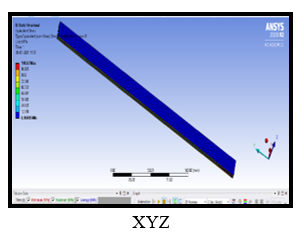
2. JBJ (Tensile Testing)
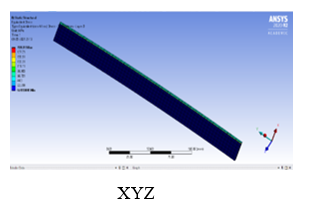
3. BJB (Tensile Testing)
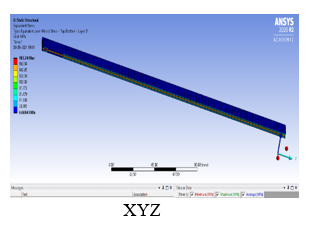
4. JJB (Tensile Testing)
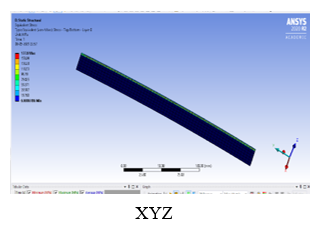
B. Flexural Test
Flexural test determines the flexural stiffness and strength properties of composites.Three point loading flexural test is considered for our testing where sample specimen is provided with two fixed supports and load applied on the center of the specimen.Test need to be performed as per the ASTM standards.Some of ASTM standards for performing flexural test are ASTM D7264,ASTM D4762 etc. For our sample we have considered the ASTM D7264 standard.The flexural properties also depend on which surface of the sample the force is applied.Sample size is 64mmx12.7mm.
- BJB (Flexural Testing)
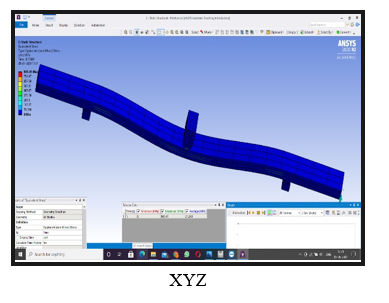
2. BBJ (Flexural Testing)
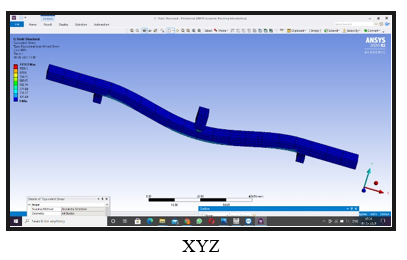
3. JBJ (Flexural Testing)
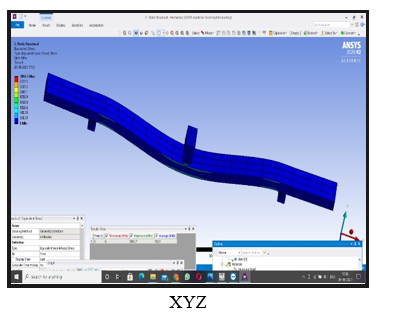
4. JJB (Flexural Testing)
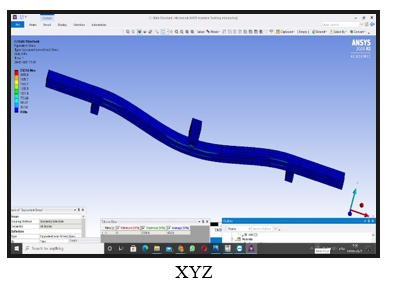
C. Shore Hardness Test
Shore hardness is defined as a measure of the resistance of a material to indentation under specified conditions of force and time. Shore D and Shore A hardness scales are commonly used scales, with scale A being used for soft polymers and scale D being used for Hard polymers. Durometer is the device used to measure Shore Hardness. The hardness values are obtained between 0 and 100.Specimen has been as per ASTM D 2240 standard and shore hardness D scale for our specimen to obtain hardness. The flexural properties also depend on which surface of the sample the force of indentation is applied. The fabricated samples are cut in 5mmx5mm for Shore hardness test.
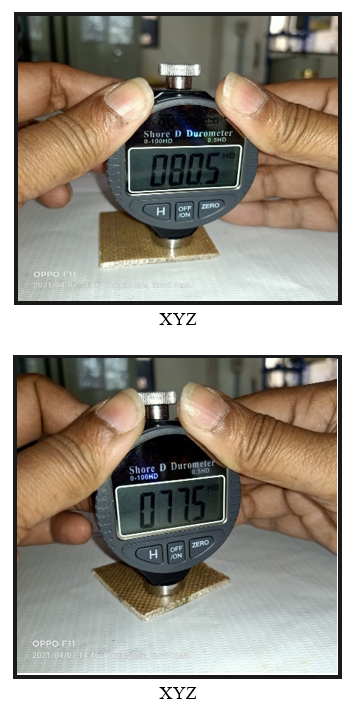
|
STACKING SEQUENCE |
Tensile Stress(MPa) |
Flexural Stress(MPa) |
Shore Hardness D (avg) value |
|
BJB |
183.24 |
845.41 |
80 |
|
BBJ |
199.91 |
1131.2 |
84 |
|
JBJ |
106.7 |
3061.7 |
75 |
|
JJB |
177.8 |
2321.6 |
71 |
III. DISCUSSION
A. Tensile Analysis
From the above table the tensile stress of the BBJ stacked hybrid composite is higher compared to other orders due to higher composition of banana fibre in it.But this contradicts that statement BJB has lower tensile stress compared to BBJ Here the stacking order plays an important role as jute having lower tensile strength and this is compensated by two layers of banana fibre .This is why BBJ has high tensile strength compared to BJB .Tensile strength of banana fibre = 529-914 MPa Tensile strength of jute Fibre = 200 - 500 MPa.
B. Flexural Analysis
The hybrid composites with jute in skin and banana at core (JBJ) showed better flexural property compared to other stacking. sequences. Presence of higher composition of jute fibre in the composite resulted in improving the elongation of the overall composite and JJB being next to JBJ is evident from the above results.Presence of banana fibre in higher composition results in lower displacement of the roller and permanent deformation starting at lower flexural stress compared to other stacking orders.The flexural properties also depends on which surface of the sample the force is applied. Here the force is applied on a surface from the left in the mentioned sequence (BJB,BBJ,JJB,JBJ) i.e. For the JJB sequence force is applied on the jute surface.By this it is evident that change in stacking sequence influences the flexural properties.
C. Shore hardness D Analysis
The shore hardness value is higher for BBJ stacked hybrid composite .This shows that presence of banana fiber in higher composition has greater resistance to plastic deformation .BJB is lower than BBJ and this indicates that consecutive alignment of banana fibre tend to show better hardness value .JJB showed lower hardness value among all the stacking orders due to presence of jute fibre in large composition .Here the force of indentation is applied on a surface from the left in the mentioned sequence (BJB,BBJ,JJB,JBJ) i.e. For the JJB sequence,force is applied on the jute surface.The Shore Hardness value depends on which surface of the sample the force of indentation is applied.
Conclusion
The Banana-Jute Hybrid fibre reinforced epoxy composite samples have been fabricated by Hand layup process and Shore hardness D values of these samples are obtained.The same composite samples were modelled in ANSYS software and tensile properties,flexural properties are obtained. The following are the conclusions: Based on the tensile test, the tensile strength exhibited by the composite material with stacking of banana fiber is significant. When compared with other hybrid composites, the B/B/J stacking order had the highest tensile strength.In the flexural test, the flexural strength is highest for the composite material with the stacking sequence of jute-banana-jute fiber reinforced epoxy matrix composites (JBJ)In the shore hardness test the banana-banana-jute stacking sequence showed better hardness value ,while the stacking sequence with jute-jute-banana obtained less hardness value than others. Overall analysis shows that the stacking sequence of the banana fiber and jute fiber has a considerable effect on the mechanical properties of the Banana-jute hybrid fibre reinforced epoxy composite.
References
[1] V Manoj Kumar1 and M Prasanna Kumar,Experimentation on Hybrid Composite of Banana and E-Glass Fiber, IRJET , Volume:07 , Issue:06, e-ISSN: 2395-0056 ,p-ISSN: 2395-0072 [2] Merlini C., Soldi V. , Barra G. M. O., Influence of Fiber Surface Treatment and Length on Physico?Chemical Properties of Short Random Banana Fiber-Reinforced Castor Oil Polyurethane Composites, Polymer Testing, 30 (2011), pp. 833–840. [3] Mohanty S., Nayak S.K., Effect of Mercerized Banana Fiber on the Mechanical and Morphological Characteristics of Organically Modified Fiber-Reinforced Polypropylene Nanocomposites, Polymer-Plastics Technology and Engineering; 2011;50(14):14581469.DOI: 10.1080/03602559.2011.593079 [4] Boopalan M.,Niranjana M., Umapathy M.J., Study on the mechanical properties and thermal properties of jute and banana fiber reinforced epoxy hybrid composites, Composites: Part B; 2013; 51:54-57. [5] Pothan L.A., Thomas S., Polarity parameters and dynamic mechanical behavior of chemically modified banana fiber reinforced polyester composites, Composites Science and Technology; 2003; 63: 1231–1240 [6] Venkateshwaran N, ElayaPerumal, A Banana fiber reinforced polymer composites – A review, J Reinf Plast Compos 2010;29:2387–96. [7] M.Ramesh, Palanikumar K, Hemachandra Reddy K (2013), \"Mechanical Property evaluation of sisal-jute-glass Fiber Reinforced Polyester Composites, Composites Part B, Volume 48, Pages 1-9. [8] Mohanty,A.K, Misra, M, Studies on Jute composites - a literature review, Polymer Plastics Technology and Engineering, 729-792,1995. [9] Venkateshwaran N, ElayaPerumal, A Banana fiber reinforced polymer composites – A review, J Reinforced Plastic Composites 2010;29:2387–96. [10] Dash.D, Samanta.S, Gautam.S.S, and Murlidhar.M, Mechanical Characterizations of Natural Fiber Reinforced Composite Materials, Journal of Advanced Materials and Manufacturing Characterization, Vol.3, No.1, pp. 275 – 280, 2013. [11] Madhukiran.J, Srinivasa Rao.S, Madhusudan.S, Fabrication and Testing of Natural fiber reinforced Hybrid composites, International Journal of Modern Engineering Research, Vol.3, No.4, pp.2 239 – 2243, 2013.
Copyright
Copyright © 2022 Dasagrandhi Veda Swaroop. This is an open access article distributed under the Creative Commons Attribution License, which permits unrestricted use, distribution, and reproduction in any medium, provided the original work is properly cited.

Download Paper
Paper Id : IJRASET40581
Publish Date : 2022-03-01
ISSN : 2321-9653
Publisher Name : IJRASET
DOI Link : Click Here
 Submit Paper Online
Submit Paper Online

